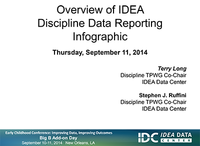Site Search
Results 155 - 158 of 158
Format: Presentations
Equity, Inclusion, and Opportunity: Addressing Success Gaps via the SSIP ProcessPresenters introduced a research-based guidance document and self-assessment rubric designed by OSEP's Disproportionality Priority Team to help districts and schools identify the root causes of "success gaps" for some groups of students, thereby helping to improve and equalize results for all students. As an example, presenters used Georgia's SSIP process, focused on graduation for students with disabilities.
Format: Presentations
Overview of IDEA Discipline Data Reporting InfographicThe presentation reviewed a new TA tool that summarizes the basics of reporting IDEA discipline data in the six EDFacts file formats. Presenters described and demonstrated the new IDC infographic, discussed how SEAs and LEAs can use it to improve the quality of their discipline data, and requested audience input.
Format: Presentations
Standards, Assessments, and Indicator 3: A Landscape of the States to Facilitate Interactive Discussions on Data Quality Challenges for Indicator 3Members of IDC's Tools and Products Assessment workgroup presented an overview of states and entities across several pertinent variables: a) current information on each state's standards, current state assessments, and assessment plans; and b) 2011-12 information on Part B Indicator 3. Presenters conducted an interactive discussion identifying data quality issues around Indicator 3 and solicited suggestions for tools and products to improve data quality for this indicator.
Format: Presentations
Equity, Inclusion and Opportunity: Addressing Success GapsThe presentation introduces a research-based guidance document and self-assessment rubric designed to help districts and schools identify the root causes of "success gaps" (for example, in test scores, suspension or graduation rates, or course credits) for some groups of students, thereby helping schools to improve and equalize results for all students.





